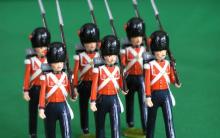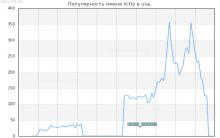Management is a field of activity that is present literally everywhere. Wherever modern man goes, everywhere some people rule others, and this is the law of both capitalism and the nature of people in general.
Management has found its application in business, in the government system, and even in personal relationships between people, because in any group there is a person who can call himself a leader. Next we will talk about types of management and characteristics, and you will also learn about the specific application of this science.
What will happen without management?
Many people, the overwhelming majority of them subordinates, condemn the management hierarchy system, because... consider it immoral for one person to control another. But then let's imagine what would happen if there were no leaders at all. And then we would get approximately the following picture: there is a crowd of uncontrollable workers who do not understand what exactly they need to do for one simple reason - no one told them this.
All control is completely absent, which is why some particularly zealous employees begin to openly parasitize, and I haven’t yet talked about the money that needs to be distributed to someone. Thus, bosses are important in any enterprise and in any group, which is why management was, is and will be a relevant area.
Types of management and their characteristics!

- Operational management is the last type of management. Its characteristics are as follows: an operational plan is created with a time limit of no more than a month for its implementation, entrusted, as a rule, to a small manager or directly to the executor, after which it is put into action. This may include scheduled and unscheduled inspections, small projects at the enterprise, etc.
Where is management applied?
- Leadership systems are common in marketing. There are always people here who can come up with brilliant ideas and effective advertising campaigns, and there are those who bring ideas to life. And the better the communication and understanding between managers and performers is established, the more productive the work of the entire department will be and the greater the company’s profit.

- Some companies have a specific department that collects information about the sales market, competitors, etc. There are few levels of different kinds of managers, but there are those who collect information and those who process and analyze it. These two groups of people must act in a coordinated and productive manner.
- Management is also used in the system for selling a product or service. There are main sellers here, and there are ordinary people who must listen to advice and follow the orders of their seniors. Marketers may also be subordinate to marketers who tell them how to advertise and sell certain products.
- Management is also expressed in the service sector, because there are those who directly provide services and those who manage the entire process. An example would be restaurants where there are waiters, cooks, administrators and a director.

Anti-crisis management!
A special form of leadership is crisis management, which is introduced when financial difficulties arise. As a rule, if an organization is on the verge of bankruptcy, it takes all measures to get out of a difficult situation. In this case, a kind of state of emergency is introduced, only within one company. 
The powers of senior management are significantly expanded; now they can initiate an audit or begin an internal investigation at any time. Control on the part of top managers and the owner is also increasing, whose main task is to eradicate corruption and all kinds of violations. During such periods, there may be a reduction in staff and production costs.
Management in the underworld!
As I already wrote in one of my previous articles, hierarchy and leadership are present not only among law-abiding citizens, but also among criminals. In particular, we can distinguish criminal organizations that consist of several people and have strict hierarchical ties. Management is also used here, although not always legal. And law enforcement officers must take this into account when fighting crime.
Afterword...
So, now you have an idea about the types of management and their characteristics. In the end, I would like to add that management is not only the prerogative of business or the state administrative system, but a field of activity that is present everywhere, from a specific family to the largest monopoly or state.
Main types of management
1.Strategic management- management, which deals with solving the most important, global problems of the organization as a whole. Strategic management is aimed at determining the global goals that the organization strives for. The main objects of attention of strategic management are: 1) the mission of the organization; .2) problems of the organization’s external environment; 3) establishing plans in the long term;
2.Production management is aimed at making decisions regarding the use of certain technologies, equipment loading, volumes and structure of product output, in other words, optimizing the production process. Optimization involves searching for a production organization in which the resources available to the enterprise (materials, equipment, money, labor) are used most profitably, in such a way that they bring the maximum possible benefit at minimal cost.
3.Personnel management is aimed at increasing the efficiency of personnel use. A manager working in this area must resolve issues related to the search, training and development of employees. In addition, the tasks of the HR manager include developing methods of stimulating and rewarding employees, thanks to which their work will be more fruitful. Finally, the HR manager must ensure that the professional level of employees is high enough.
4. Marketing management“responsible” for organizing the organization’s relationship with the market. And this presupposes, firstly, the organization of effective receipt of information about the market: about consumers, their desires, about competitors and the goods they offer. Secondly, the tasks of marketing management include managing the most important decisions regarding how an organization presents its product or service on the market, that is, product positioning, advertising, etc. The main goals of marketing are: 1) extracting sustainable (or maximum) profits and 2) gaining advantages over competitors.
5.Innovation management aimed at creating and introducing new types of goods or services, as well as technologies. To do this, it is necessary to conduct numerous studies, decide in what form the product will be favorably received on the market, and determine how to make the costs of producing the product minimal. Naturally, innovation management resolves issues related to the introduction of new developments into production.
Basic principles and functions of management in modern conditions.
Management principles
Specific features of management, i.e. creativity of managers are implemented using certain principles.
Principles – rules, norms, instructions for action.
The market concept of management required a revision of management principles. New principles related to the informal management model were formulated:
loyalty to employees;
responsibility is a prerequisite for successful management;
an atmosphere in the company that promotes the development of employees’ abilities;
timely response to environmental changes;
establishing the share of each employee in the overall results;
methods of working with people to ensure their satisfaction with their own work;
communications that permeate the company horizontally and vertically;
direct participation of managers in group activities at all stages as a condition for coordinated work;
honesty and trust in people;
the manager’s ability to listen to everyone he encounters in his work;
business ethics is the golden rule of management;
quality of personal work and its continuous improvement;
reliance on the fundamental principles of management: quality, costs, service, innovation, resource control, personnel.
Management functions
Specific features of management, i.e. creativity of managers are implemented using certain functions.
Functions are types of activities through which the subject of management (manager, enterprise management apparatus) influences the managed object (work collective).
Control functions are:
general – part of the management cycle, characterized by a regular type of activity;
specific - determined by belonging to a specific stage of the production process;
special – a subfunction of a specific function.
In this case, the objectively necessary functions are:
organizational and technical (coordination and coordination of activities in the production process);
socio-economic (control over labor, use of machines and mechanisms).
Any enterprise is considered as a complex system for which it is necessary to determine the composition of management functions and take into account the following factors:
resources: material, labor, financial, equipment, buildings, structures, information, production technology, product;
management decision-making cycle: preparation, approval, implementation, evaluation;
stages of the product life cycle.
- 1. Let's start with strategic management. It is needed in order to plan and ensure the implementation of long-term tasks that are created for a period of more than 1 year. This could be the management of the construction of a large facility, the business plan of an organization, or even the well-known state budget for the next year. In order for the plan to be executed exactly and on time, there are people who control it and manage the performers. As a rule, a whole group of managers is created, whose main task is to manage the implementation of the strategic plan. Moreover, it is important to understand that far-reaching plans are very approximate, they do not give clear instructions, so managers need to think about how best to fulfill a certain prescription. For example, it was ordered to place 6 offices, a toilet and a manager’s office on the second floor of a business center, but in what order and how exactly to do this is decided by the responsible managers who carry out the management.
- 2. The second type of management is tactical management, also known as medium-term management. This includes all plans for which implementation is allocated from a month to a year. For example, this could be the restructuring of departments in an enterprise, a marketing campaign, etc. To perform such tasks, new groups can be created or tasks can be entrusted to existing ones (marketing department, labor protection department). The instructions in these plans can be both approximate and precise, so the manager still needs to be able to think and make the right decisions.
- 3. Operational management is the last type of management. Its characteristics are as follows: an operational plan is created with a time limit of no more than a month for its implementation, entrusted, as a rule, to a small manager or directly to the executor, after which it is put into action. This may include scheduled and unscheduled inspections, small projects at the enterprise, etc.
- 5. Approaches The effectiveness and quality of managerial work is determined, first of all, by the validity of the methodology for solving problems, i.e. approaches, principles, methods; Without good theory, practice is blind. However, to date, only a few approaches and principles are applied to management, although more than 13 scientific approaches are currently known:
- 1. Complex. When applying an integrated approach, technical, environmental, economic, organizational, social, psychological, political and other aspects of management and their relationships should be taken into account. If you miss one of them, the problem will not be solved.
- 2. Integration. The integration approach to management is aimed at researching and strengthening the relationships: - between individual subsystems and elements of the management system; - between stages of the life cycle of a control object; - between control levels vertically; - between control levels horizontally.
- 3. Marketing. Provides for the control subsystem to focus on the consumer when solving any problems: - improving the quality of the object in accordance with the needs of the consumer; - saving resources for the consumer by improving quality; - saving resources in production due to factors of production scale, scientific and technical process (STP); - application of the management system.
- 4. Functional. The essence of the functional approach to management is that a need is considered as a set of functions that need to be performed to satisfy it. After establishing the function, several alternative objects are created to perform these functions and the one that requires the minimum total costs for the life cycle of the object per unit of useful effect is selected.
- 5. Dynamic. When applying the dynamic approach, the control object is considered in dynamic development, a retrospective analysis is performed for five or more past years and a prospective analysis (forecast).
- 6. Reproductive. This approach is focused on the constant resumption of production of goods and services to meet market needs in comparison with the best technological object in a given market.
- 7. Process. Considers management functions as an interconnected management process, is the total sum of all functions, a series of continuous interrelated actions.
- 8. Normative. The essence of the normative approach is to establish management standards for all subsystems of the management system. Standards should be established for the most important elements: - target subsystem; - functional subsystem; - supporting subsystem.
- 9. Quantitative. The essence of the quantitative approach is the transition from qualitative to quantitative assessments using mathematical statistical methods, engineering calculations, expert assessments, a point system, etc.
- 10. Administrative. The essence of the administrative approach lies in the regulation of the functions of rights, responsibilities, quality standards, costs, duration, elements of management systems in regulations.
- 11. Behavioral. The goal of the behavioral approach is to help the employee understand his own capabilities based on the approach of modern behavioral sciences. The main goal of this approach is to increase the efficiency of the company by increasing human resources. Behavioral science will always contribute to improving the efficiency of both the individual employee and the company as a whole.
- 12. Situational. Focuses on the fact that the suitability of various management methods depends on the specific situation. Since there is such an abundance of factors both within the company itself and in the external environment, there is no best single approach to managing an object.
- 13. Systemic. With a systems approach, any system (object) is considered as a set of interconnected elements that has an output (goal), input, connection with the external environment, and feedback.
The most important principles: - the decision-making process should begin with the identification and clear formulation of specific goals; - necessary identification and analysis of possible alternative ways to achieve the goal; - the goals of individual subsystems should not conflict with the goals of the entire system; - ascent from the abstract to the concrete; - unity of analysis and synthesis of logical and historical; - manifestation in an object of different quality connections and interactions.
Scientific management- based on the application of scientific approaches and principles, modern methods of development and management decision-making at different stages of the life cycle of an object.
Information management- a type of functional management, a system for providing the control subsystem with quality information for decision-making and operational management. Basic requirements: use of the latest technology and technical means; ensuring the ability to encode information through the use of flowcharts, graphs, diagrams, dependencies for disclosure of materials, ensuring the quality of information, reliability, sufficiency, timeliness.
Organizational management– a type of functional management that reveals issues of organization theory, the study of company management systems, and human organizational behavior. Basic requirements: knowledge of the essence of the laws of organization, trends in the construction, functioning, development and withering away of various organizational structures.
Marketing-quality– a type of functional management that characterizes issues of quality theory, research of competitive advantages in quality, construction and operation of quality systems, certification tests and certification. Basic requirements: application of scientific approaches to ensure product quality; quality certification; application of the basics of standardization and metrology; product quality management systems in accordance with international standards (ISO 9000 series).
Development of a management decision (RMD)– a type of functional management that reveals theoretical and practical issues of RUR and its implementation on various management issues. Primary requirements; classification of sustainable development, parameters and conditions for ensuring the quality and effectiveness of management decisions, ensuring the comparability of alternative options, taking into account risk factors and uncertainty when making management decisions.
Investment management– a type of functional management that reveals theoretical and practical issues of choosing and justifying investment directions, organizing and developing the implementation of investment projects. Primary requirements; classification of investment areas, priority of innovative investments in the conditions of a transition economy, classification of investment projects and technology for their development, feasibility study of investment projects, registration, coordination and approval.
HR management– reveals theoretical and practical issues of personnel management using administrative, economic, socio-psychological methods. Basic requirements: determining the place of personnel management in the entire management system; knowledge of the principles and methods of personnel management and the application of scientific approaches; the ability to draw up a psychological portrait of a person, assess the business qualities of a manager, form teams, identify formal and informal leaders; selection, training and retraining of personnel; labor motivation system; legal and methodological resource support; scientific organization of labor (SLO); leadership styles and stress and conflict management.
Financial management– a type of functional management that reveals theoretical and practical issues of ensuring sustainability, reliability, progressiveness and efficiency of management of financial organizations, as well as the organization’s finances. Basic requirements: application of scientific approaches and management principles to the financial activities of the organization; system of financial indicators, application of analysis and synthesis of the formation of financial indicators; Marketing and forecasting methods in financial management. Types, structure and content of the balance sheet, tax and credit policy.
Strategic management– a type of functional management that reveals theoretical and practical issues in the formation of an organization’s strategy. Basic requirements: managing product development cycles, developing a strategy for management decisions; analysis of competitive advantages; methodology for forming company strategies, methods for improving product quality, strategy for resource conservation and organizational and technical development of the company.
Innovation management- a type of functional management that reveals theoretical and practical issues of organizing R&D, technological preparation for the production of innovations, their sales and service in order to increase competitiveness and efficiency. Basic requirements: evolution of technical structures, classification of innovations and their coding; mechanism for supporting innovation activities; personnel management in an innovative organization, comprehensive support and formation of a portfolio of innovations and innovations.
Production management- a type of functional management that reveals theoretical and practical issues of planning and creating production of products. Basic requirements: structure and content of the production management system; types of leaders; individual and team; groups and their importance, organization of preparation for the production of new products.
There is also management of the social environment, banking, tax, administrative, emergency management, risk management, international, tourism, hotel management.
4. Stages of development of management as a science. Schools of Management.
Scientific management concept (20-30s of the 20th century).
In the USA, management is becoming established as a science and an independent activity. The founder of the concept of scientific management is Frederick Taylor. He wrote the book “Principles of Scientific Management”, after the publication of which management began to be considered an independent field of study. Taylor argued and articulated that management work is a specialty and that the organization as a whole benefits from having a group of workers focus on what they do best.
At this stage, the approach from the perspective of various management schools was determined:
· School of Scientific Management
· Classical (administrative) school
· School of human relations and behavioral science
· Quantitative School (School of Management Science)
Lecture 10. Concept and content of various types of management
Types of management are special areas of management activity related to solving certain management problems. Based on the object, a distinction is made between general and functional management (Fig. 1).
Figure 1. Objects and types of management
General or general management consists of managing the activities of the organization as a whole or its independent economic units (profit centers).
Functional or special management consists of managing certain areas of activity of an organization or its units. For example, innovation, personnel, marketing, finance, etc.
Based on content, normative, strategic and operational management are distinguished.
Regulatory management involves the development and implementation of the organization's philosophy, its entrepreneurial policy, determining the organization's position in the competitive market niche and the formation of general strategic intentions.
Strategic management involves the development of a set of strategies, their distribution over time, the formation of the organization's success potential and the provision of strategic control over their implementation.
Operational management involves the development of tactical and operational measures aimed at the practical implementation of the adopted development strategies of the organization.
Organizations undergo certain processes of object management. These include human resource management, operations management, etc. However, these are also private types of management that take place in organizations. They have appropriate names: personnel management, operational management, etc.
To achieve goals in any type of management, it is necessary to purposefully influence teams of departments, individual workers, and coordinate their activities.
Operations management. Operations management has always been one of the main factors determining the efficiency of an enterprise. Various operations management strategies provide significant improvements in productivity, process reliability and the competitiveness of the company as a whole. There are several definitions of the concept “operations management”:
This is the activity of managing the process of acquiring materials, converting them into a finished product, and delivering that product to the buyer;
This is the management of the production of goods and services;
This is an activity related to the development, use and improvement of production systems on the basis of which the company's main products or services, etc., are produced.
Strategic management. A strategic approach to management means the creation of a unified enterprise management system focused on stable operations in the long term, strengthening competitiveness and increasing efficiency. Strategic management Management activities concerned with setting the goals and objectives of the organization and with maintaining a set of relationships between the organization and its environment that enable it to achieve its goals, correspond to its internal capabilities and allow it to remain responsive to external demands.
Innovation management. Innovation management (R&D and implementation of their results into production) is one of the main areas of activity of any company. In the world economic literature, “innovation” is interpreted as the transformation of potential scientific and technological progress into real progress, embodied in new products and technologies. Innovation has many definitions; for example, I. Schumpeter interprets innovation as a new scientific and organizational combination of production factors, motivated by the entrepreneurial spirit. Innovation management– a set of principles, methods and forms of management of innovation processes, innovation activities, organizational structures and their personnel engaged in these activities. Innovation management, like any direction of management, is associated with the implementation of management functions (planning, organization, motivation, control). The subject of innovation management is a system for managing innovation activities, covering innovation processes at the level of one organization and across the state economy.
Personnel management. One of the key factors in the production of any type of goods and services, along with investment capital (fixed assets and working capital), is labor resources. Effective labor management, as a special function of activities related to the hiring of workers, their training, evaluation and payment of their work, is an important prerequisite for the effective functioning of production. Trained and qualified workers on staff of an enterprise are called its personnel, or personnel. The main goal of personnel management is to provide the enterprise with employees who meet the requirements of this enterprise, their professional and social adaptation. Personnel management- this is an activity at enterprises (organizations) aimed at the most effective use of employees to achieve organizational and personal goals.
Quality management. There is a direct relationship between management categories such as efficiency and quality. The quality of the manufactured product increases the market share of the enterprise, helps to survive in a competitive environment, leads to lower costs and, ultimately, helps to increase the efficiency of the entire production. Quality management is a system of measures to ensure guaranteed quality of a product or service.
Unlike operational management, the concept of production management is already associated only with production activities. However, it should be discussed in more detail, because for manufacturing enterprises it is important. Production management is an activity that relates to the creation of goods.
Activities to create goods and services exist in all organizations. In manufacturing organizations, this is production activity. For such activities, it is best to use the term “production management.” In other organizations that do not create physical goods, production functions are “hidden” from the buyer. This could be an activity that takes place in a bank, airline office or university. Such production (service) activities usually relate to operations or operations management.
In production management, the subject of management most often are business managers and numerous management bodies. Objects of management are enterprises, work collectives, workers, factors of production in the form of tools and objects of labor, natural resources, scientific, technical and information potential. Control influences are represented by laws, decrees, plans, programs, regulations, standards, recommendations, instructions, materials and financial incentives and levers, moral influence. Feedback is the results of direct observations and control by the subject of management: documentation, reporting, etc.
The central unit of production management is the enterprise. Each enterprise produces products, goods, services, and carries out its main activities. This is his main goal and task, the meaning of existence. It follows that the basis of enterprise management is the management of the production process, regardless of whether the organization produces goods or services, knowledge or information.
In order to produce any economic product, it is necessary to use production factors, economic resources: labor, equipment, raw materials, materials, information, money. Consequently, enterprise management includes the management of employees, means of production, production resources, finances, and technologies.
All of the above forms the basis of production management and is its subject. Based on this, production management can be defined as a system of forms and methods of managing the economy of an enterprise, aimed at achieving optimal results in its production, commercial and financial activities.











The benefits of sunflower seeds for the heart, hair and nerves
Why do my legs give way at the knees?
Name energy: how the patronymic influences fate and the birth program Name patronymic meaning character
First Chinese Emperor
Alfred the Great: biography